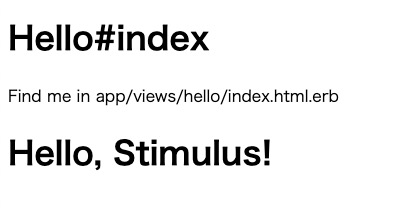Using stimulus.js with Rails
Environment
- macOS Mojave 10.14.3
- Rails 5.2.2
- ruby 2.6.1
What is Stimulus
Stimulus is a JavaScript framework developed by the Basecamp team, well-known for Rails. It has good compatibility with Rails and can coexist with turbolinks.
It’s a perfect JavaScript framework for small development teams or individual developers who don’t have dedicated front-end engineers.
Getting Started
To manage gems on a per-project basis, do the following:
$ mkdir stimulus
$ cd stimulus
$ bundle init
Edit the Gemfile:
# frozen_string_literal: true
source "https://rubygems.org"
git_source(:github) {|repo_name| "https://github.com/#{repo_name}" }
# gem "rails"
gem 'rails', '~> 5.2.2'
Next, run bundle install --path vendor/bundle. In subsequent runs, --path vendor/bundle is not needed.
$ bundle install --path vendor/bundle
Rails new
Although you can install stimulus with rails new --webpack=stimulus, I chose to install stimulus afterwards because I had trouble fixing webpack configuration errors.
$ bundle exec rails new . -B -d postgresql --skip-coffee
$ bundle exec rails db:create
$ bundle exec rails s
If you get the following error after bundle exec rails db:create:
Could not find gem 'pg (>= 0.18, < 2.0)' in any of the gem sources listed in your Gemfile.
$ brew uninstall postgresql
$ brew install postgresql
$ bundle install --path vendor/bundle
Installing Webpacker gem
Install the Webpacker gem.
Add the following line to your Gemfile and run bundle install. I’m specifying the version here because gem 'webpacker', github: 'rails/webpacker' would install version 4 which caused errors.
# Gemfile
gem 'webpacker', '~> 3.5'
Run bin/rails webpacker:install. Make sure to install Yarn beforehand if you don’t have it.
$ bin/rails webpacker:install
Installing Stimulus
$ bundle exec rails webpacker:install:stimulus
After completing these steps, your app/javascripts/packs/application.js should look like this:
# app/javascripts/packs/application.js
/* eslint no-console:0 */
// This file is automatically compiled by Webpack, along with any other files
// present in this directory. You're encouraged to place your actual application logic in
// a relevant structure within app/javascript and only use these pack files to reference
// that code so it'll be compiled.
//
// To reference this file, add <%= javascript_pack_tag 'application' %> to the appropriate
// layout file, like app/views/layouts/application.html.erb
console.log('Hello World from Webpacker')
import { Application } from "stimulus"
import { definitionsFromContext } from "stimulus/webpack-helpers"
const application = Application.start()
const context = require.context("./controllers", true, /\.js$/)
application.load(definitionsFromContext(context))
Next, add <%= javascript_pack_tag 'application', 'data-turbolinks-track': 'reload' %> to your views/layouts/application.html.erb.
# views/layouts/application.html.erb
<!DOCTYPE html>
<html>
<head>
<title>Stimulus</title>
<%= csrf_meta_tags %>
<%= csp_meta_tag %>
<%= stylesheet_link_tag 'application', media: 'all', 'data-turbolinks-track': 'reload' %>
<%= javascript_include_tag 'application', 'data-turbolinks-track': 'reload' %>
<%= javascript_pack_tag 'application', 'data-turbolinks-track': 'reload' %>
</head>
<body>
<%= yield %>
</body>
</html>
This completes the stimulus configuration.
Creating a hello stimulus example
$ rails g controller Hello index
View:
# views/hello/index.html.erb
<h1>Hello#index</h1>
<p>Find me in app/views/hello/index.html.erb</p>
<div data-controller="hello">
<h1 data-target="hello.output"></h1>
</div>
Next, create hello_controller.js in the following directory:
app/javascripts/packs/controllers/hello_controller.js
// app/javascripts/packs/controllers/hello_controller.js
import { Controller } from "stimulus"
export default class extends Controller {
static targets = [ "output" ]
connect() {
this.outputTarget.textContent = 'Hello, Stimulus!'
}
}

